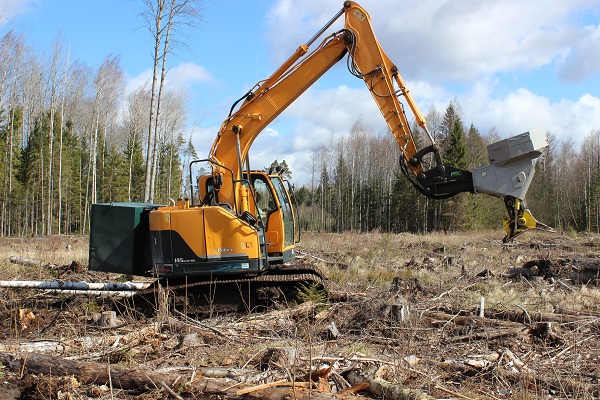Advantages of Mechanized Forest Planting in Latvia
JSC “Latvia's State Forests” (LVM) uses mechanized forest planting to carry out reforestation works more efficiently, especially in places where reforestation with traditional methods is difficult. In 2021, an area of 900 ha was planted mechanically using eight technical units.
Mechanized forest planting is more suitable for wet mineral soils and wet peat soils, where earth uplifts must be made to reduce the risks posed by surface water. The forest planting machine creates an earth uplift before setting in a seedling. The practice of reforestation shows that trees planted on uplifts grow better because their roots are protected from excess moisture, there are better light conditions and less competition with the surrounding vegetation, which is especially important in the first years after planting. This helps the tree to adapt more quickly to the new conditions, creating a strong root system and good growth already in the first growing season.
“In Latvia's climatic conditions, forest owners need to use several types of soil preparation, including the search for solutions to reduce the rising costs and labour shortages. One solution is to create uplifts in the ground. Earth uplifts can be formed with a special unit – a rotating device – or with an excavator equipped with a conventional digging or special bucket. Scandinavian foresters have created a technology in which an excavator sets in a container seedling while simultaneously making an uplift. This is done with a special device mounted on the excavator, called a planting head. This solution of mechanized forest planting promotes the competitiveness of this technology, since it is not necessary to plant the forest by hand,” says Edmunds Linde, Head of Forestry Planning at LVM.
Tested in studies
In Latvia, too, the first experiments with mechanized forest planting were carried out already back in the 1980s. At that time, units developed by both local and Scandinavian designers were tested. After regaining independence, mechanized planting trials were resumed, but with an excavator equipped with a special planting head. In cooperation with scientists of the Latvian State Forest Research Institute “Silava”, experimental plantations were set up in several replicates: in 2007, 2008 and 2017 in the territory of SIA “Rīgas meži”, JSC “Latvijas Finieris” and JSC “Latvia's State Forests”. M-Planter and Bracke planting heads were used in the experiments for planting spruce, pine and birch container seedlings. When evaluating the experimental plantations, it was concluded that the tree in-growth was good and the further development of young plants was successful.
Economic benefits
LVM introduced mechanized planting with excavators equipped with a planting head in 2019, initially involving one, and in 2021 – already eight technical units. It is planned to continue using mechanized planting to increase the volume. The rapid development of the technology can be explained by costs. In 2021, the price of mechanized forest planting was 580 euros per hectare, whereas soil preparation with a bucket combined with manual forest planting was 565 euros per hectare. For LVM, another significant factor in the comparison of technologies is the resource required for the administration of works. The machine allows you to reduce the number of people involved in planting, thus reducing administrative costs. Consequently, mechanized planting technology is also economically viable. It is likely that next year, as labour costs increase, the cost of planting forests with machinery will be lower than for the traditional method.



